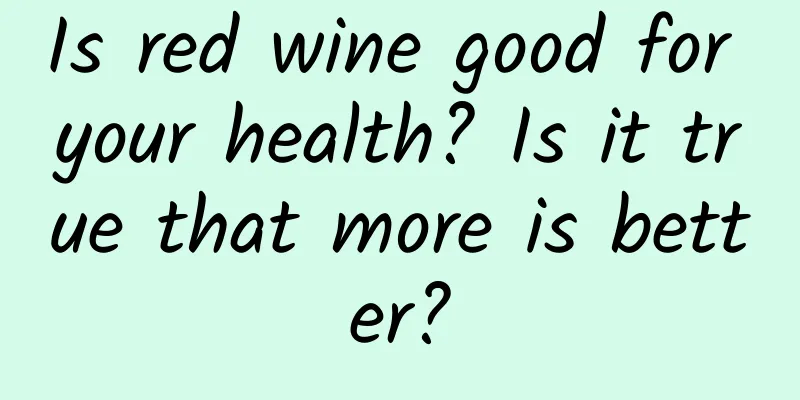Is red wine good for your health? Is it true that more is better?

|
Red wine has a history of 100 years in my country. After integrating with modern human civilization, it has formed a unique red wine culture and gradually entered the public's field of vision during its dissemination. With the continuous development of the red wine market, the consumer group's cognition of red wine and its nutritional value has a certain degree of deviation. Therefore, it is necessary for us to correctly understand red wine and the connotation of red wine culture. Wine Origin: In Xinjiang, Ningxia and other regions of my country, due to the advantages of climate and geographical environment, the grape planting area is large, the yield is high, and the varieties are rich. The production and development of grape planting and wine has become a sunrise industry. With the unique natural conditions, high-quality and abundant raw material resources, and the continuous improvement of winemaking technology, the wine production in the western region has shown a huge production capacity advantage and has become a strong representative of the development of the domestic wine industry. As a category of wine, red wine is mostly produced in the western region. The wine brewed in Xinjiang is deeply loved by the public. Xinjiang is at the same geographical latitude as Bordeaux, France, which enjoys the reputation of "Wine Capital". The light, heat, water and soil resources are very suitable for wine grape planting. Xinjiang has a history of more than 2,000 years of wine production. It is a eugenic area for wine and the source of Chinese wine culture. Since Emperor Wu of the Han Dynasty, Zhang Qian, opened the Silk Road, the wine culture that spread eastward has entered the vision of Chinese literati. Emperor Taizong of Tang was a die-hard fan of wine. He once wrote a poem praising the wine brewed by the famous minister Wei Zheng: "It is more fragrant than orchids, and the green waves are more beautiful than jade. I can stay drunk for a thousand days, and the taste never fades in ten years." Emperor Taizong himself participated in the brewing of wine in the palace. The Tang Dynasty poet Wang Han wrote in "Liangzhou Ci": "The grape wine is in the luminous cup, and the pipa music urges me to drink." This popular poem has become the most beautiful interpretation of people's love for wine. The poet Li Bai also had a special liking for wine. In "Song of Xiangyang", he lamented: "A hundred years have 36,000 days, and I have to drink 300 cups a day. Looking from afar, the duck heads in the Han River are green, just like grape mash for the first time to ferment." Drinking wine has become an important part of the poetic life of literati throughout history, and the related drinking culture has also been passed down. Wine culture: In the Chinese food culture, the importance of red wine can be seen. People have strict requirements on wine drinking skills, red wine taste, food pairing, red wine bottle packaging, red wine brewing process, red wine brand, etc. The pleasure of tasting red wine and mastering red wine etiquette have gradually become an indispensable part of people's lives. Consumers' pursuit of red wine quality and choice of red wine flavor and taste reflect people's pursuit of elegant and exquisite life to a certain extent. For the preservation of red wine, the ideal storage temperature is between 10℃ and 15℃, with 5℃ as the lower limit and 20℃ as the upper limit. Storage temperature that is too high or too low will affect the delicate taste of red wine. Nutritional value of red wine: With the spread of red wine culture, the health care knowledge and nutritional value related to it have also received widespread attention from the public. Many published papers and research practices have shown that red wine has certain health care functions and nutritional value. For example, drinking red wine in moderation can promote blood circulation, protect the heart, and prevent some cancer diseases, so many people ignore the harm of excessive drinking. Some studies have also shown that certain extracts in red wine seem to prevent tooth decay, but there are also reports that if the wine contains sugar and acidic substances, it will also damage teeth. Therefore, when facing the relevant knowledge of red wine, we need to carefully distinguish and look at it scientifically and rigorously. The academic community's understanding of the nutritional value of red wine has also gone through different stages. Initially, studies believed that alcohol and the incidence of cardiovascular and cerebrovascular diseases showed a U-shaped correlation, that is, within a small dose range, drinking alcohol may indeed reduce the risk of cardiovascular and cerebrovascular diseases. Later, in-depth research based on large sample data showed that even small doses of drinking can lead to an increased risk of cardiovascular and cerebrovascular diseases, especially East Asians are more sensitive to it. It can also cause arrhythmias, and it is concluded that even small amounts of drinking can induce disease risks. More studies have confirmed that alcohol is closely related to liver diseases, digestive system diseases, endocrine diseases, reproductive system diseases, and nervous system diseases. Even drinking a small amount of alcohol cannot ensure that it has no adverse effects on human health. Resveratrol, which is considered to be the essence of red wine, is mainly found in edible and medicinal plants such as grapes, mulberries, and peanuts. Modern research shows that it has pharmacological effects such as anti-inflammatory, anti-thrombotic, platelet aggregation inhibition, and anti-tumor, and is an effective ingredient in many traditional Chinese medicines for the treatment of inflammation and heart disease. Because the content of resveratrol in grape skin is relatively high, some scholars speculate that the resveratrol contained in red wine has the function of preventing diseases, but subsequent research data and practice have shown that this may not be the case. Resveratrol is indeed beneficial to improve certain indicators that are unfavorable to human health, but it is mainly alcohol that plays an important role in disease prevention. Therefore, we should pay special attention to alcohol. Notes on drinking: People's Daily Online Science Popularization China once invited experts to discuss the issue of drinking and health, and clearly stated that the common saying that "moderate drinking is good for health" is incorrect. Experts explained that moderate drinking is beneficial to reducing the risk of certain cardiovascular and cerebrovascular diseases, but no matter how much you drink, it will increase the risk of atrial fibrillation and the probability of other cardiovascular diseases. Therefore, experts recommend that "drinkers should limit their drinking, and non-drinkers are not recommended to start drinking 'appropriately' to prevent diseases." Under the infiltration of Chinese wine culture, alcohol can no longer be erased from the lives of most people, so when drinking, you need to pay attention to the amount of intake and avoid excessive drinking. Children, adolescents, pregnant women and breastfeeding women should abstain from alcohol. The "Dietary Guidelines for Chinese Residents" 2016 pointed out: "Children, adolescents, pregnant women and nursing mothers should not drink alcohol. If adults drink alcohol, the amount of alcohol consumed by men in a day should not exceed 25g, and that of women should not exceed 15g." What does this mean? 25 grams of alcohol is equivalent to 750 ml of beer, or 250 ml of wine, or 50 grams of high-proof liquor, or 75 grams of 38° liquor. And 15 grams of alcohol is equivalent to 450 ml of beer, or 150 ml of wine, or 50 grams of 38° liquor. For people who are allergic to alcohol, people who already have certain diseases (such as hypertriglyceridemia, pancreatitis, liver disease, etc.) should not drink alcohol. People with high blood uric acid levels should not drink a lot of beer. The development of red wine culture has an important impact on the development of modern economy and society, and the spread of culture and art. It represents a spiritual pursuit of modern people's lives. To a certain extent, the existence of red wine has added a bit of elegance and sensibility to people's ordinary lives. Therefore, we can spread the connotation and spirit of red wine culture. As for drinking, a total ban on alcohol is not in line with China's national conditions, and it is also contrary to our cultural traditions. For thousands of years, Chinese wine culture has allowed wine to penetrate every corner of social life, but we must understand that although red wine is good, it is not a "myth"! Remember to control it reasonably, a small drink can make you happy, but drinking too much can hurt your body. [1] Wang Xiaojun. Effect of fermentation temperature on resveratrol content in Cabernet Sauvignon and Merlot red wines from Manasi region. Modern Food, 2021, 7 [2] Wang Yaya. Potential beneficial health effects of resveratrol: confusion caused by pharmacokinetics. Chinese Journal of Clinical Pharmacology and Therapeutics, 2021, 8 [3]Zhou Qi. Red wine can prevent tooth decay[J]. Science Popularization World (Information Edition), 2010(02):4 [4]Wu Huan. Western red wine: waiting for new opportunities[J]. Western China, 2006(Z1):52-59. [5]Chinese Nutrition Society. Dietary Guidelines for Chinese Residents (2016)[M]. Beijing: People's Medical Publishing House, 2016. [6]Liu Shun, Li Heyu, Zhao Ling. Research progress on the effects of resveratrol on lowering serum uric acid and anti-inflammatory effects[J]. Drug Evaluation Research, 2016, 39(02): 304-307. [7] Li Jinliang. Study on the morphological analysis and distribution characteristics of iron, copper and manganese in wine. Northwest A&F University, Master's thesis, 2021,5 [8]Liu Shun, Li Heyu, Zhao Ling. Research progress on the effects of resveratrol on lowering serum uric acid and anti-inflammatory effects[J]. Drug Evaluation Research, 2016, 39(02): 304-307. |
>>: [National Ear Care Day] How much do you know about the incessant tinnitus?
Recommend
My period hasn't come yet and I'm still irritated
During women's menstrual period, their body&#...
What causes dark spots on the labia?
The labia is the most private part of a woman. As...
How long will it take to have a second baby?
Many families hope to have two children, a boy an...
Can eggs be kept out of the refrigerator? Why do we eat eggs during the Dragon Boat Festival?
The ancients believed that round eggs symbolize a...
Itchy red bumps on lower body
I believe many women have a certain understanding...
Girls should not eat too much dietary fiber
In recent years, foreign scientists have observed...
Are electric mosquito coils harmful to pregnant women?
In the summer, not only is the hot weather annoyi...
Treatment for miscarriage and no menstruation for 40 days
The incidence of menstrual problems cannot be und...
Black color for a few days before menstruation
Irregular menstruation is a common gynecological ...
Tips for girls to grow taller after menarche
Is it possible for girls to increase their menstr...
Acidic environment is more likely to give birth to a daughter
Human body constitution is divided into alkaline ...
Can I have induced labor at 13 weeks?
Many female friends encounter some problems when ...
Is colorectal cancer a "foolish cancer"? If you have these 4 symptoms, it is recommended to check as soon as possible!
In the past six months, Ms. Fang has suffered fro...
Will removing the IUD damage the endometrium?
Removing the IUD may damage the endometrium and m...
Why do I have toothache at night after pregnancy?
During pregnancy, many pregnant women will encoun...









